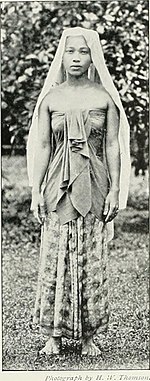Kelantanese Malays
Shafi'i branch) | |
| Related ethnic groups | |
|---|---|
| Other Malays |
Kelantanese Malays (
The Kelantanese Malays, along with
Genetics
A research on population genetic structure of Malay sub-ethnic groups published in 2011 revealed that Kelantanese Malays formed a separate independent clade, suggesting that Kelantanese Malay had an ancestry that is more divergent than any other Malay sub-ethnic groups.[2] This means, there might be evidence that the Kelantanese Malays are genetically different from other Malay populations. It was suggested that there are two explanations to the findings. First, the geolocation of the cradle of Kelantanese in the northeast of the Malaysian peninsula, separated by Titiwangsa mountain range, accounted for their limited links to the Indonesian Archipelago. The other explanation is that the sub-ethnic group might be an admixture with the Indian population in ancient times during the early existence of the Malays.[3]
Language
Kelantanese Malays speak a highly divergent Kelantanese Malay, also known as Baso Kelate or Kecek Kelate by its native speakers. The language is known for its "e" and "o" sounds which is very different from standard Malay. One of the examples are "Saye" (which means love) but in Standard Malay it is called "Sayang" and "Mano" (which means where) but in Standard Malay it is "Mana". Kelantanese Malay has its own distinct grammar and vocabulary which makes other Malay speakers (except those in Terengganu and Southern Thailand) find it very difficult to understand. Kelantan-Pattani Malay has its own ISO 639-3 code "mfa". Kelantanese Malay has its own regional dialects but still mutually intelligible to one another, it is also spoken natively in Besut and Setiu (Terengganu) and similar varieties can be found in neighbouring Perak and Kedah but the latter two are considered variants of Pattani dialects instead of Kelantanese.[4]
Culture
Kelantan is known by many as the "Cradle of the Malay civilization" in Peninsular Malaysia. Its culture is unique and different from those of other Malay sub-ethnic groups other than those in Southern Thailand. Due to their historic and geographic location, it also has considerable influences from
Cuisine
There are a variety of Kelantanese Malay cuisine that includes:-[6]
- Akok, made of eggs and brown sugar.
- Ayam Percik, roasted chicken served with coconut milk sauce.
- Buah Tanjung, made of eggs, flour and sugar. Also a royal dish.
- Budu (sauce)
- Roasted Etok[7]
- Jala Mas, similar taste to Buah Tanjung. Main ingredients are eggs and sugar. Also a royal dish.
- Kerutuk Daging
- Kuzi Ayam
- Laksam, made from rice flour and served with coconut milk broth and Ulam (salad).
- Lempok
- Lompat Tikam, a dessert dish made from rice flour, sugar and Pandan leaf extract.
- Nasi kerabu
- Nasi dagang
- Nasi tumpang
- Puteri Mandi, made of sticky rice and served with sweeten grated coconut.
- Serunding Daging
- Tahi Itek, made of eggs, coconut milk and sugar.
Craft
- Songket Kelantan
- Wau bulan
- Gasing
- Crush gear
Dance
Among the popular traditional Kelantanese Malay dance are such as:-[8]
- Tarian Asyik
- Tarian Hala
Theater
- Main Puteri, a form of entertainment and also healing or exorcism.[9]
- Mak Yong
- Menora (dance)
- Wayang Kulit
Music
- Dikir barat
- Kertok
- Rebana Ubi
Martial arts
Notable people
- Menteri Besar of Kelantan.
- Haji Mohd Hassan bin Munas, a resistor of colonial British Malaya famously known as Tok Janggut.[10]
- Mohd Badhri Mohd Radzi, Malaysian footballer.
- Mohd Daudsu Jamaluddin, Malaysian footballer.
- Mohd Farisham Ismail, Malaysian footballer.
- Mohd Khairul Izuan Rosli, Malaysian footballer.
- Mohd Qayyum Marjoni Sabil, Malaysian footballer.
- Menteri Besar of Kelantan.
- Nik Shahrul Azim Abdul Halim, Malaysian footballer.
- Wan Khalmizam, Malaysian professional archer.
- Wan Zaharulnizam Zakaria, Malaysian footballer.
- Khairul Fahmi Che Mat , Malaysian footballer.
- Ahmad Muin Yaacob, Malaysian convicted murderer.
- Rozman Jusoh, Malaysian convicted drug trafficker.
- Misha Omar, Malaysian actress and singer.
References
- ^ a b "Laporan Kiraan Permulaan 2010". Jabatan Perangkaan Malaysia. p. 27. Archived from the original on July 8, 2011. Retrieved 2016-02-07.
- ^ Mohd Tajuddin Abdullah, PhD. "Population genetics of Malay subgroup". www.academia.edu. Retrieved 2016-05-13.
- PMID 27090249.
- ^ ISBN 978-16-442-9758-2.
- ASIN B011C9TDQE.
- ^ "Makanan Tradisional". Portal Resmi Kerajaan Negeri Kelantan. Archived from the original on 2015-02-15. Retrieved 2016-02-07.checked:yes
- ^ Rosalwani Che Soh (1 May 2017). "'Mengokok' etok tarik ramai penyertaan". Sinar Harian. Retrieved 2017-05-09.
- ^ "Tarian Tradisional Melayu". Tarian Tradisional. Retrieved 2016-02-07.
- ^ "5 Kelantanese Performing Arts You Never Knew Existed!". travel3sixty. Retrieved 2016-02-07.
- ISBN 978-96-740-8079-2.




